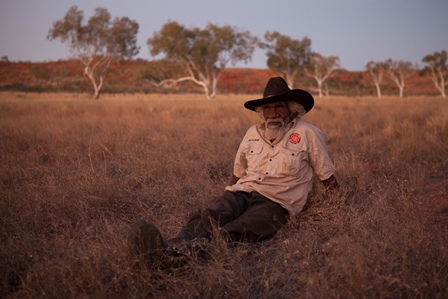Collisions still. Photo credit Piers Mussared.
Lynette Wallworth is working at the cutting edge of a form whose future is still unknown: virtual reality.
The Australian filmmaker-artist has been nurtured by Sundance's New Frontier sidebar, celebrating its 10th anniversary this year.
New Frontier presents developing tech and cutting-edge experimental work. Wallworth describes it as "anything that isn't the traditional cinema experience".
The multi-disciplinary artist is currently in California, in the middle of conforming her latest film, Collisions, before presenting at New Frontier for the third time.
Wallworth previously exhibited an interactive installation, Evolution of Fearlessness, and in 2013 she brought the John Maynard-produced Coral: Rekindling Venus to Park City: Kenneth Turan of the LA Times called the full-dome film "immersive cinema at its most spectacular".
Soon after Sundance 2015, at which "VR really hit in a very big way", Sundance senior programmer and curator of New Frontier, Shari Frilot, started talking to Wallworth about the possibility of a residency.
She was placed with a Palo Alto-based company, Jaunt VR, who are "pushing the technology in terms of the hardware as well the player – both how you would capture the work as well as how the work is presented".
While most VR work is captured on GoPros, Jaunt have just produced a new camera, the Neo – too late for Wallworth, but an indication of where the form is headed. "[Jaunt's] algorithms for stitching the array of content together is really beautiful. They're pushing the boundaries in terms of the quality of the content that you can capture".
Wallworth is flying to Switzerland next week alongside Nyarri Morgan, of the western desert's Martu people, whose story the film documents. They will present the film at the World Economic Forum in Davos.
"The Martu's country is in the western desert of WA, in the Pilbara region", Wallworth said. "They were amongst the last indigenous peoples in this country whose traditional lives were interrupted by Western culture. [They] were living traditionally until the 1960’s. Nyarri is probably in his 80’s, and he was walking about in that desert until his life was interrupted by an extreme event of western technology".
After toying for a long time with making the work an installation, Wallworth realised that VR was the perfect medium in which to tell Nyarri's story.
"It's a powerfully immersive form. You feel yourself to be present in the work. That is what is yet to be explored: what that means for storytelling. Many early VR works have been more akin to an experience than a narrative".
So were the earliest films, of course – and VR represents the fascinating possibility of a new frontier: in which the immersion of cinema and the agency of gaming merge.
Collisions will be coming to ACMI in October, as well as to the Adelaide Film Festival, who invested in the film.
And obviously, noted Wallworth, "we’ll be sending a lot of VR headsets out into the desert, so Nyarri and his grandson Curtis will be able to tour the work around to communities. Which is the lovely thing about it – the ability to download the work onto a headset and make it shareable. I had imagined it would be a technology that would suit Nyarri because of the 360 degree experience. And it did. He looked at this camera and said ‘oh, it’s got sixteen eyes’. Seeing that, he could determine where the camera could go – and where it couldn’t”.


